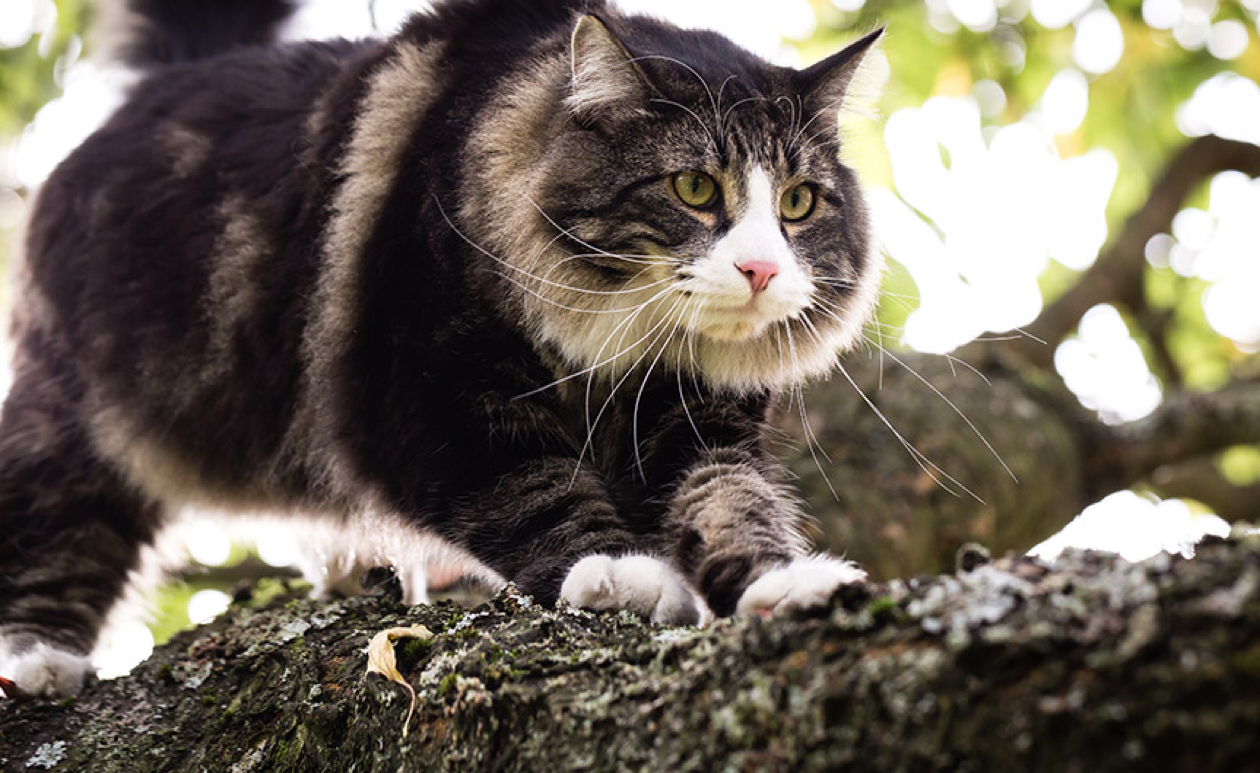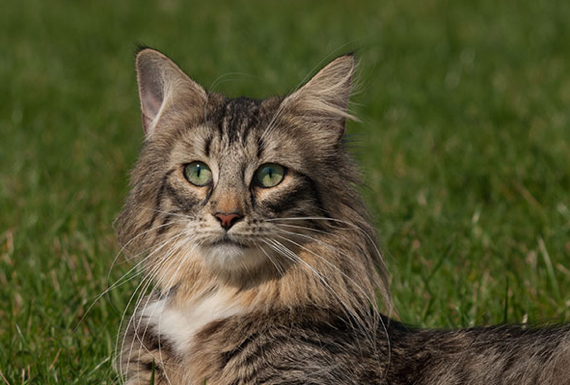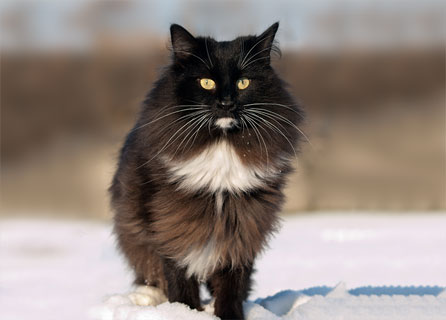
All about your Norwegian Forest Cat
The Norwegian Forest Cat, affectionately known as the ‘Wegie’, is a loving feline who enjoys being around their family, but will come and go as they please. Find out what you need to know about this large, long-haired cat, from their temperament and how they should be groomed, to their health and exercise needs.
Breed information & advice
The friendly Norwegian Forest Cat is clever and independent – not your typical lap cat. As an athletic breed they love climbing, so don’t be surprised to find them at the top of wardrobes or bookcases around your home. Here’s more you should know:
- They enjoy playing with a family, although can be a little reserved around visitorsThey enjoy playing with a family, although can be a little reserved around visitors
- Despite having a beautiful, long-haired coat, they won’t require a huge amount of grooming – a brush anywhere between once and three times a week means you shouldn’t have any issue with mattingDespite having a beautiful, long-haired coat, they won’t require a huge amount of grooming – a brush anywhere between once and three times a week means you shouldn’t have any issue with matting
- They'll typically weigh between 4kg and 8kg, when fully grownThey'll typically weigh between 4kg and 8kg, when fully grown
- A healthy Norwegian Forest Cat will usually live for 13 to 16 yearsA healthy Norwegian Forest Cat will usually live for 13 to 16 years
Typical size of a Norwegian Forest: Large

Recommended exercise & nutrition
The Norwegian Forest Cat is large, heavy-boned and enjoys plenty of playful exercise. Take time to incorporate regular play time into your cat’s day and allow space for them to roam about – this will help them to control their weight too. Because they love to climb and explore, try to introduce perches around your house to encourage them to stay in shape.
Feed your cat a balanced diet of high-quality food each day – the amount will vary depending on their size and age, and always read the food packet instructions. Watch their diet carefully to help prevent them from becoming overweight.
Wild at heart
The Norwegian Forest Cat still displays hunter-like tendencies, so you may often find them chasing and ambushing toys.

Common health problems & illnesses
There’s no reason why your Norwegian Forest Cat shouldn’t live a long and happy life. However, being aware of the ailments your cat will be more prone to, along with the associated symptoms, can help you to deal with any health issues that crop up.
Norwegian Forest Cats are prone to a deficiency in the enzyme Pyruvate Kinase, which impairs the red blood cells' ability to metabolize, which may lead to anemia and other blood-related issues. This condition is typically associated with a genetic defect at birth. Cats that undergo a bone marrow transplant may have a normal lifespan. Unfortunately, this is life threatening for those that are left untreated. Please speak to your vet if you have any concerns.
Glycogen Storage Disease Type IV is caused by a branching enzyme deficiency that causes an inability to metabolize glucose properly, resulting in an accumulation of an abnormal form of glycogen in the muscles and liver. This disorder leads to the enlargement or malfunction of different vital organs in the body and can also lead to muscular degeneration. Symptoms may become evident after about five to seven months of age, but the disorder more commonly manifests within the womb, causing stillbirth or death soon after birth, primarily from hypoglycemia.
Cardiomyopathy relates to any disease that affects a cat’s heart muscle, and can affect this breed. Hypertrophic cardiomyopathy is one of the more common of these heart conditions and causes thickening of the heart’s muscles, making it more difficult for the organ to relax between contractions. Keep an eye out for any signs in your cat such as loss of appetite, weakness or difficulty breathing. Speak to your vet, who will be able to do a full examination and advise on treatment options, if you have any concerns.
This is an inherited condition where cysts (pockets of fluid), form in the kidneys. They gradually increase in size until the kidney cannot function normally, resulting in kidney failure. The number of cysts and the rate at which the cysts enlarge varies between cats. There is currently no way of predicting how rapidly the disease will progress in a particular cat. The diagnosis is based on breed, medical history, clinical signs, blood and urine tests, genetic testing, and ultrasound evaluation of the kidneys. Special radiographic dye studies may also be used in certain situations. Please speak to your vet.
Cat name popularity
If you’re struggling to think of a name for your Norwegian Forest Cat, take a look at the most popular ones at Tesco Bank Pet Insurance for inspiration.
Freya
Loki
Molly
Mia
Daisy
Average treatment costs
Wondering whether pet insurance for your Norwegian Forest Cat is worth it? We’ve put together the top five conditions claimed for by Tesco Bank Pet Insurance customers in 2021. To give you an idea of how much vet bills can vary, we’ve shown both the average cost and the top 10% most expensive costs for each condition.
Top five conditions and average costs
|
Condition |
Average cost |
10% most expensive |
|---|---|---|
|
Respiratory condition |
£1,059 |
£2,082 |
|
Diarrhoea |
£215 |
£333 |
|
Vomiting |
£303 |
£445 |
|
Lymphoma |
£1,361 |
£2,262 |
|
Fractured tooth |
£1,120 |
£2,022 |
Tesco Bank Pet Insurance claims data from paid treatments including excesses from 01/01/21 to 31/12/21.
Considering Norwegian Forest Cat insurance?
We know your cat is an important member of the family, so give them the protection they deserve with Tesco Bank Pet Insurance.
Tesco Bank Pet Insurance is arranged, administered and underwritten by Royal & Sun Alliance Insurance Ltd.
Grooming advice
The Norwegian Forest Cat’s long coat will tangle or become matted if it’s left unattended, so it’s a good idea to brush or comb anywhere between once and three times a week. This will also reduce the number of hairballs you find around the house. They will shed their thick winter coat in the spring, so you’ll need to comb them more during this period.
Kittens’ coats don’t start developing until they’re three months old, though it can take two years before their coats reach full maturity.
Keep their nails in good condition by trimming them weekly. By checking their ears every week, you will be able to spot signs of infection, such as redness or a bad smell – clean them with a dampened cotton ball to remove any dirt or debris. This breed is also prone to periodontal disease, so it’s important to brush their teeth, ideally on a daily basis, with a vet-approved toothpaste.
Try to introduce your kitten to grooming early on so they’ll learn to accept it as part of their routine.
Fun & interesting facts
- This giant feline is Norway’s national cat.This giant feline is Norway’s national cat.
- The breed has been around for 4,000 years – and it’s thought they were used to keep rats off Vikings’ ships.The breed has been around for 4,000 years – and it’s thought they were used to keep rats off Vikings’ ships.
- Norwegian Forest Cats are known as “fairy cats” in Norse folklore and are said to be favoured by Freya, the goddess of love and beauty.Norwegian Forest Cats are known as “fairy cats” in Norse folklore and are said to be favoured by Freya, the goddess of love and beauty.
- They have their own built-in snow shoes – long tufts of hair in between their toes to protect them from frostbite.They have their own built-in snow shoes – long tufts of hair in between their toes to protect them from frostbite.
- In 2015, a Norwegian Forest Cat named Beebz helped to save their owner’s life when she had a seizure.In 2015, a Norwegian Forest Cat named Beebz helped to save their owner’s life when she had a seizure.
Important information
The content on this page aims to offer an informative introduction to pet breeds, but does not constitute expert veterinary advice. If your dog or cat falls ill or has an injury, contact your vet immediately. Tesco Bank Pet Insurance has a partnership with vetfone™ which means that as a customer, you can benefit from their advice as part of your policy.
Tesco Bank Pet Insurance is arranged, administered and underwritten by Royal & Sun Alliance Insurance Ltd. The vetfone™ service is provided by VetsDirect Ltd.
All facts and figures were correct at date of publication and were compiled using a range of sources.
Vetfone™ is a 24/7 unlimited, free telephone or video call service that provides expert advice from vets or vet nurses qualified with the RCVS (Royal College of Veterinary Surgeons). If your pet has a medical emergency, or you need advice on health, grooming, feeding or behaviour Vetfone™ is there to help.
As a Tesco Bank Pet Insurance customer, you can access friendly, expert advice from qualified Royal College of Veterinary Surgeons as a standard benefit with your policy, and the service is provided at no additional cost. A quick telephone call or video call could answer any questions you have about your pet, give you peace of mind and could even save you a trip to the vet.
Tesco Bank Pet Insurance is arranged, administered and underwritten by Royal & Sun Alliance Insurance Ltd. The vetfone™ service is provided by VetsDirect Ltd.
Discover more breeds
Browse our other cat and dog guides to learn about some of the UK’s most popular breeds.
